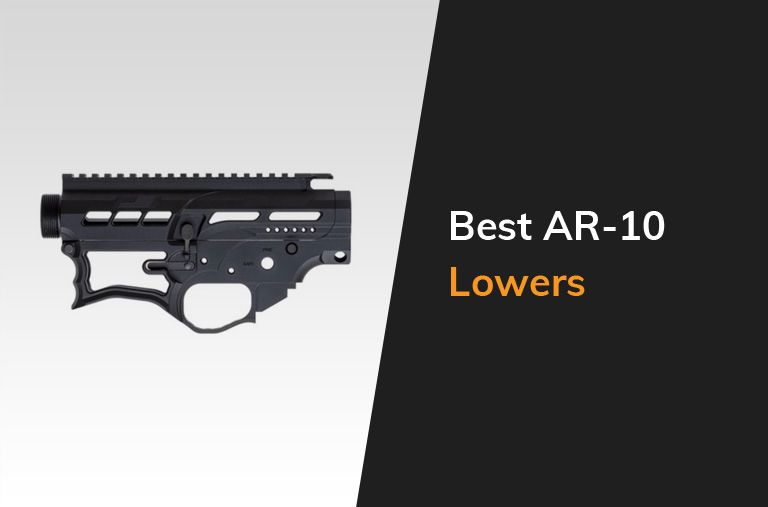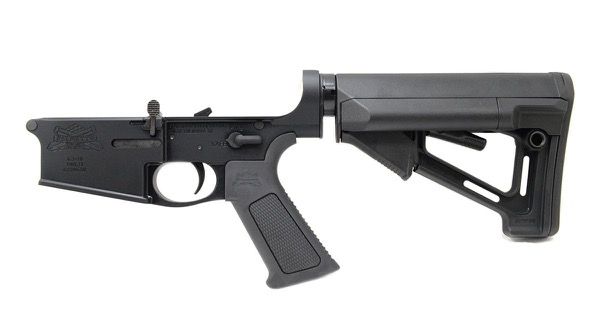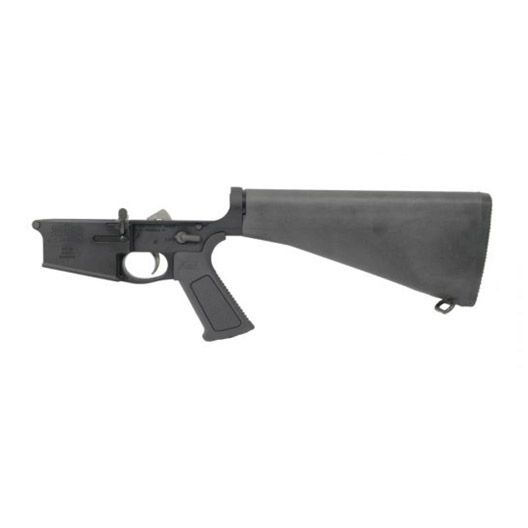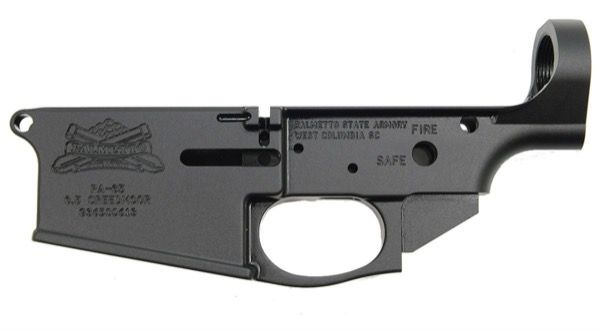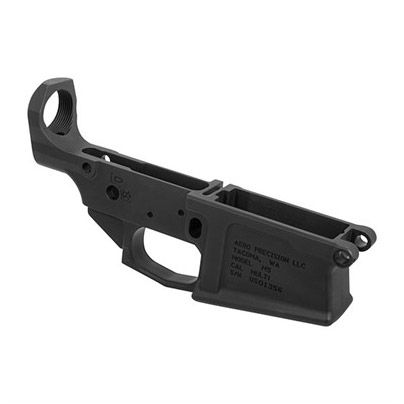At a Glance: Best AR-10 Lowers
- OUR TOP PICK: Aero Precision 308 AR Lower Receiver
- TOP RATED: Brownells BRN-10 Lower Receiver
- BEST BUDGET OPTION: James Madison Tactical 308AR 80% Lower Receiver with Jig
Comparison of The Best AR-10 Lowers
| PRODUCT | DETAILS | ||
|---|---|---|---|
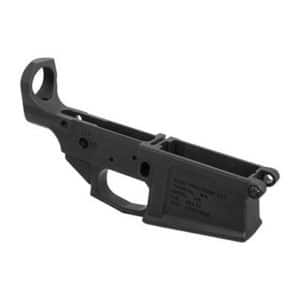
Our Top Pick
|
Aero Precision 308 AR Lower Receiver |
|
View Latest Price |
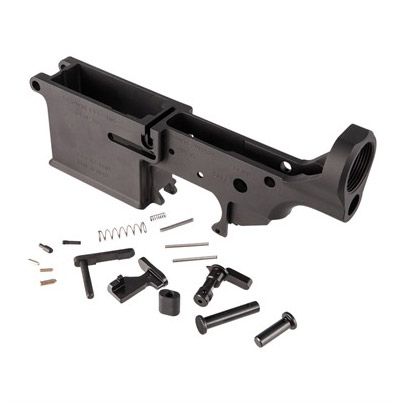
Our Top Pick
|
Brownells BRN-10 Lower Receiver |
|
View Latest Price |
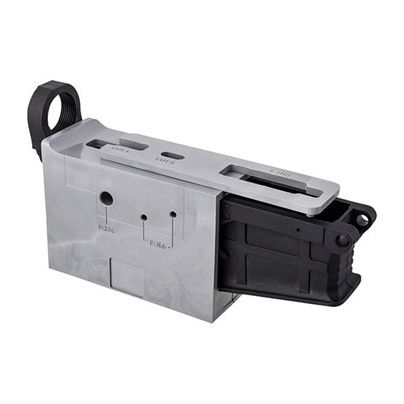
Our Top Pick
|
James Madison Tactical 308AR 80% Lower Receiver with Jig |
|
View Latest Price |
Our Blueprint for Success: A Guide to the 5 Best AR-10 Lowers
A good rifle should not only perform well at the range, but it should just feel right. One of the best parts about completing a custom rifle build is that you have the opportunity to select every part from the stock to the barrel.
Receivers are the centerpiece of your rifle, which is why it is important that you select a great AR-10 lower and upper receiver for your build.
Building an AR-10 is a blast and can lead you to create a gun that you will love. With that said, AR-10 builds are a little different than AR-15 builds because of a lack of uniformity in the cuts of the receivers.
Buying a receiver that is of poor quality or one that is simply cut with weird specs will leave you frustrated and waste your hard-earned money. Thankfully, we have eliminated the guesswork and narrowed your search down to five great lowers to kick off your AR-10 build.
What Is the Lower Receiver?
The term receiver simply refers to the body of the rifle that houses various internal parts involved in the firing of ammunition. Every rifle has a receiver.
This includes parts like the trigger assembly and bolt carrier group. In traditional rifles such as the old bolt-action that I grew up shooting, the receiver is generally one solid structure.
A Solid Foundation
While other parts such as the trigger and barrel play the largest role in influencing the accuracy of your rifle, the receivers are the foundation. A poor-quality lower receiver can result in durability concerns, result in a poor fit of other components, and even cause safety issues in extreme circumstances.
Spending hundreds of dollars on carbon fiber barrels and top-grade triggers is awesome, but it all starts with good receivers. I liken it to putting $35 retreads on a brand-new Maserati. The car will probably drive but you are cheating yourself, and a failure will be catastrophic.
A good friend of mine got into a rush to finish his AR build a while back and settled for a cheapo upper receiver. While at the range, he decided to try a high-performance hunting round that he intended to use in the upcoming season. Long story short, the upper couldn’t handle the pressure of the blowback and burst open at the top, nearly taking the tip of his nose with it.
Different Types of Lower Receivers
Now that we have narrowed down your search to five solid options, there are two main factors you should consider before pulling the trigger and kick-starting your build.
You have to decide if you want a stripped, 80% lowers, or finished lower receiver.
Material: Polymer vs Billet vs Forged
AR-10 lowers are generally manufactured of polymer or aluminum. The aluminum receiver will be categorized as either forged, billet, or cast but all three are finished through CNC precision machining. Casted lowers are rarely used because billet and forged receivers that are CNC machined provide much better results, hence the reason our list omitted cast receivers entirely.
Polymer receivers offer the lightest weight of any option, but the difference between a good billet receiver and a polymer one will only be a few ounces. Polymer receivers are a good choice for the casual shooter, but I like a more durable option for heavy, frequent use like hunting applications or competitive shooting.
For those that are building a rifle for hunting or optimal long-distance accuracy, which I would imagine describes most people building a rifle chambered in .308 WIN, billet or forged are the way to go. Choosing between the two is basically a matter of preference and your goals with your build.
If you opt for a billet receiver, I would strongly recommend purchasing the matching upper receiver to ensure that you don’t have any fitting issues between the two. As long as you like the look and design of the brand of upper, you will be happy with this choice and save yourself a ton of frustration.
If you are sold on the idea of hand-picking every part of your rifle and have decided on an upper receiver, then the forged lower is your best bet. A forged receiver is also a great choice if you plan on doing a custom 6.5 Creedmoor build in the future or want to leave your options open. You could do the same with a billet receiver but again would need to stick with the same brand of upper.
Complete AR-10 Lower Receviers
PSA GEN3 PA10 Forged Complete STR SSA-E .308 Lower With Over Molded Grip
Gen 3 PA-10 Complete Lower Receiver! Designed with customer feedback in mind, this is fully assembled and ready for your complete PA10 Gen3 Upper! You will be happy with the 2 stage Geissel trigger. This bad boy is designed where weapon accuracy and reliability are critical.
FEATURES
- Geissele Super Semi-Automatic Enhanced (SSA-E) Trigger
- Magpul STR Stock
- PSA Overmolded Pistol Grip
- PA10 Short Buffer & PA10 Buffer Spring
- Twice Staked M4 Lock Nut
Pros
- Fantastic Geissele Trigger
Cons
- Recommend only using PSA PA10 parts with PSA uppers and lower receivers
PSA Gen3 PA10 .308 Complete A2 EPT Rifle Lower
For our next entry, we will take a look at a complete lower receiver manufactured by Palmetto State Armory. The PSA Gen3 PA10 complete lower comes with a traditional A2 style fixed stock. Being a complete lower means that it includes all the hardware, a pistol grip, and a trigger group.
FEATURES
- Palmetto State Armory A2 Rifle Stock
- PSA Overmolded Pistol Grip
- Fixed A2 rifle receiver extension with PA10 rifle buffer and buffer spring
While buying a complete lower takes away some of the fun of a ground-up rifle build, this is a good choice for those of you that are looking to get your rifle up and running quickly. The lower is forged, which offers supreme durability compared to other methods of manufacturing. It is an AR platform rifle so swapping out parts is a breeze.
The other nice perk of a forged lower other than durability is that they tend to accommodate a wider variety of upper receivers, as long as they follow the same cut. In the case of the PA10, any AR-10 upper with the DPMS cut will fit well. While you could technically mix and match uppers and lowers that are manufactured using a billet process, those tend to present more fitting issues due to small differences in the machining process.
In addition to its ability to accommodate a good variety of upper receivers, the trigger pull is not bad at all. The resistance is consistent, and it has a clean break. I’ve fired stock rifles with way worse factory triggers. With that in mind, it is still a stock trigger and if I could swap out anything on this lower, that would be it.
Pros
- Complete lower receiver
- Forged
- Compatible with many other upper receivers
Cons
- Issues reported with buffer
- Fixed stock
- A little on the heavy side
Stripped Lower Receiver
However, if you are like me and not big on that level of “do it yourself” for your rifle build, then the stripped lower is the better choice. A stripped lower will require that it be shipped to your local FFL because it is already serialized, but the rest of your rifle’s parts can get shipped directly to your door.
It also eliminates the hassle of getting your lower serialized that comes with the 80% lowers. I find that a stripped lower strikes a happy medium between the extra leg work involved with an 80% lower and the lack of choices that comes with buying a finished lower.
PSA PA-65 GEN3 6.5 Creedmoor Stripped Lower Receiver
This is one of Palmetto State Armory’s top-rated AR-10 lower receivers. It’s recommended to match PSA Gen3 lowers to Gen3 uppers for best appearance and performance. However, it is compatible with the Gen1 and Gen2 upper receivers too.
FEATURES
- Brand: Palmetto State Armory
- Product Line: PA-65
- Platform: AR-10
- Material: 7075 Forged Aluminum
Pros
- Super accurate
- Not too much recoil
Cons
- External cosmetic differences when mixing Gen1 with Gen2 and Gen3 upper and lower receivers
Aero Precision 308 AR Lower Receiver
Our first entry for Best AR-10 Lowers is the M5 lower receiver manufactured by Aero Precision. Aero Precision is known for making great products to tight specifications and the M5 lower is no different.
It is a forged stripped lower receiver that provides great durability and is compatible with a wide variety of DPMS patterned upper receivers.
I used this receiver for my last AR-10 build with fantastic results. While forged receivers like the M5 are a little heavier than their billet counterparts, that weight serves you well when building a precision rifle. I had no compatibility issues when installing my trigger and grip because of the clean millwork on this lower that left plenty of space.
The only thing you should be aware of with the Aero Precision .308 receivers is that they have unusual pivot and takedown pins because they used proprietary dimensions that are longer than your standard pins.
They sell these pins separately and you will need them to complete your build, even if mixing this lower with a different brand of upper. Oversized anti-walk pivot and takedown pins work well too if their pins are out of stock as long as they are the same length as Aero’s pins.
For simplicity’s sake, I went with Aero Precision’s upper to complete my build. Again, you can use other brands if you’d like but I generally prefer to match upper and lowers for both fit and appearance. As long as you don’t mind dealing with the pin issue, the M5 can serve as the cornerstone of your rifle build, no matter your intended application.
Pros
- Forged aluminum
- Durable
- Compatible with other brands of upper receivers
Cons
- Requires unique takedown and pivot pins
- Pins not included
- Slightly heavier than some other options
Brownells BRN-10 Lower Receiver
Next up is the BRN-10 Lower Receiver manufactured by Brownell’s. This billet aluminum receiver comes in a matte black finish. It includes a lower parts kit, complete with pivot and takedown pins, as well as the safety selector switch and magazine release. This is a nice convenience because Brownell’s uses a few proprietary sizes on the parts for this lower, so including it saves you the hassle of having to track down the individual parts on their page.
FEATURES
- Cartridge: 308 Winchester
- Finish: Black
- Style: Stripped
The BRN-10 receiver offers a nice combination of weight and durability. The weight difference between this and a polymer receiver is negligible. The added strength of an all-aluminum receiver is well worth the few extra ounces, as you will quickly learn if you are a little more adventurous on your range drills like I am.
The BRN-10 lower receiver is cut in the DPMS pattern, which is the more universally used of the two. However, Brownell’s says that this lower is only compatible with their BRN-10 upper. As you continue to browse parts for your build, you will find that this is pretty common. Most companies take a few “liberties” in the design of AR-10 receivers, adding in an unusual dimension here or there that makes an ideal fit between receivers possible only if you use matching brands.
This fact is why I typically buy matching brand upper and lower receivers for AR-10 builds. The upper that matches the BRN-10 is excellent quality, so no worries if you end up choosing this lower for your build. It is compatible with standard trigger kits and other parts, leaving you the flexibility to design your rifle however you like.
Pros
- Lower parts kit included
- No milling necessary
- Billet aluminum
- DPMS cut
Cons
- Only compatible with BRN-10 upper
- Difficult to find compatible anti-walk pins to fit
80% Lowers
When I started research for my first build and heard the terms 80% lower, my first question was “What’s a Jig?” and I wasn’t even sure if I knew what a router looked like. If you are a Jack of All trades type that feels comfortable routing out your own lower receiver, it will result in an especially rewarding build.
James Madison Tactical 308AR 80% Lower Receiver with Jig
Next we have the JMT 80% lower receiver. This receiver is made of polymer and has aluminum reinforcements in the high-stress areas. It also includes the necessary jig to complete the receiver.
An 80% lower like this one by James Madison Tactical requires that you finish the drilling and millwork. The jig is essentially a template that is placed over the lower receiver. It has guide holes that show you exactly where to cut and drill. Finishing an 80% lower is a lot of fun as long as you have a steady hand and the tools for the job.
JMT has a list of tools and a guide on their webpage, which I definitely recommend reviewing before purchasing just to make sure you are comfortable doing the millwork. It is pretty easy with the jig, but I like to get the full scope of any job before I start it.
The lower is not serialized because it is “unfinished”, but you will need to do so once you drill it out. Some states, like mine, are pretty liberal when it comes to 80% lowers while others (looking at you California) have some pretty unusual loopholes that you have to jump through so you should consult with someone knowledgeable about your state’s laws for this one.
Now that we have covered the legal concerns, this lower is lightweight and will fit great with a DPMS cut upper receiver. Being a polymer lower, I wouldn’t recommend it for competition shooting, but it’s a great choice for the casual shooter that isn’t going to subject it too cruel and unusual punishment.
Pros
- Jig included
- Can ship directly to you
- Lightweight
Cons
- Polymer is less durable than aluminum
- The serialization process is tedious in some states
- Not ready to use out of the box
Parting Advice
Companies are developing new parts and designs all the time. While these new developments range from groundbreaking innovation to the latest gimmick, following a few general rules when building your rifle will help make sure you are happy with the final product.
Know Your Goal
Having a clear goal and intended purpose for your build should always be step one.
The purpose of your rifle will affect every aspect of your build, from the type of stock to the barrel length.
Once I have a clear goal in mind, I will then start researching my upper and lower receivers. After those are chosen, I will make a list of necessary parts and fill them in as I make a choice.
Do Your Research and Don’t Settle
My old football coach used to tell us “Do it right, do it light”.
He would usually throw out this old adage after we had already screwed something up and were logging in a dozen or so wind sprints for our troubles, but this rule applies with building guns as well. I hate having to purchase something a second time because I got impatient or rushed the first time.
Taking your time with your rifle build and selecting compatible, durable parts will give you lasting results. Trust me, I’ve skimped a time or two and opted for what was in stock that day.
I almost always ended up returning what I ordered and had to order a replacement because my rushed choice didn’t quite work the way I hoped.
FAQ
Are AR-10 and AR-15 lower receivers interchangeable?
No. Rifles such as the AR-10 and AR-15 platforms have separate upper and lower receivers that are detachable from one another. The upper receiver is the section that houses the bolt carrier group while the lower receiver will include a magazine well, trigger group, and some other small parts.
Our Pick of the Best AR-10 Lowers
While I was tempted to pick the F-1 BDRX 10 as my pick for our roundup since I have a rifle equipped with one sitting in my safe, I could not overlook the M5 lower.
It is a forged stripped lower receiver that provides great durability and is compatible with a wide variety of DPMS patterned upper receivers. If your goal is to build a high-performance big bore rifle, then you can’t go wrong with this receiver set. I may have already pre-ordered mine.

